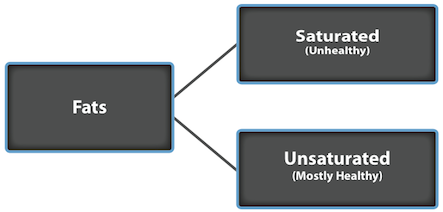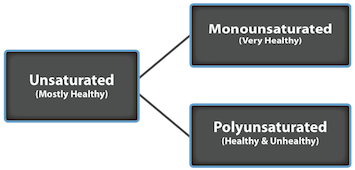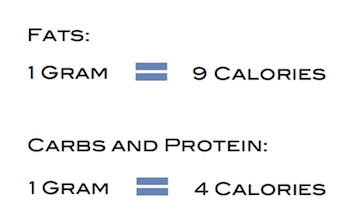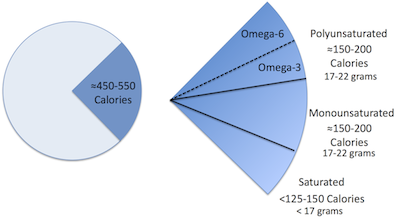Fats are the most energy dense of the three macronutrients. They provide about 9 calories per gram, while carbohydrates and proteins provide about 4 calories per gram. As a result, we have become a highly “fat-phobic” society seeking out many non- and low-fat food alternatives.
Although excessive fat intake is certainly not a healthy lifestyle choice, severely restricting intake is not healthy either. Fats are essential components of the human body and the body’s metabolic processes, and eating it does not necessarily make an individual gain weight.
Fats encase and protect our internal organs. For example, the human brain is comprised of over sixty percent fat, and this fat helps brain cells fire properly. Additionally, fats slow the rate of digestion and keep an individual feeling full longer. In brief, the right kind of fats and oils are essential to a healthy, well-balanced diet. Learn about the difference between saturated fat and unsaturated fat.
Types of Fats: Saturated Fat and Unsaturated Fat
Similar to carbohydrates (See Carbohydrates), there are healthy and unhealthy types. To understand which are healthy and which are unhealthy, one must first understand that there are two primary types: saturated fat and unsaturated fat.

Unhealthy Saturated Fat
Saturated fat contains single bonds between carbon atoms; therefore, all the remaining bonds attach to hydrogen and are fully “saturated”. They are present primarily in animal products such as beef, pork, chicken, shellfish, egg yolks, and dairy such as cream, milk, and butter. They are also present in coconut oil, palm oil, lard, and vegetable shortenings. See EMG’s full list of Food High in Saturated Fat.
Saturated fat is unhealthy. It contributes to elevated LDL cholesterol levels increasing one’s risks of heart disease, heart attack, and stroke. It should account for less than 7% of a person’s daily caloric intake (17 g per day based on a 2200 calorie diet).
Healthy Unsaturated Fat

Unsaturated fat contains single bonds and double bonds between carbon atoms; each double bond reduces the number of hydrogen attached to the molecule and therefore remains “unsaturated” with respect to hydrogen. There are two types of unsaturated fat: monounsaturated and polyunsaturated. In general, unsaturated fat is healthy.
- Monounsaturated
Monounsaturated fats are extraordinarily healthy. Examples include almonds, nuts, avocados, olive oil and canola oil. They help lower LDL cholesterol levels and can also reduce hunger levels when consumed in a well-balanced meal.
- Polyunsaturated
The two basic types of polyunsaturated fats most commonly associated with health and the human diet are omega-3 and omega-6 fats. Both of these are essential and healthy in moderation. While omega-6s are healthy in moderation, excessive consumption of omega-6s in proportion to omega-3s may increase the risk of heart disease, diabetes, and cancer. A detailed discussion of the two is presented in the following article: Polyunsaturated Fat.
Trans Fat
Another type of fat not discussed above is trans fat. Trans fat is man-made fat formed by artificially “transforming” polyunsaturated liquid fats (corn, soybean, safflower, sunflower, and cottonseed oils) to solid fats. Trans fats are entirely man-made (e.g. they do not exist anywhere in nature) and are the worst possible type of fat one can consume.
Trans fats are bad for the heart. The consumption of them increases the risk of coronary heart disease1 by contributing to increased levels of unhealthy LDL cholesterol and decreased levels of healthy HDL cholesterol. Additionally, trans fat promotes inflammation, an overactivity of the immune system that has been linked to heart disease, stroke, and diabetes.2 They also contribute significantly to weight gain. To reduce the risk of heart problems and unintended weight gain, avoid products containing them.
Fat Caloric Breakdown
Approximately, 20 to 25% of your diet should come from fats. Based on a 2200 calorie diet, this percentage equates to anywhere between 50 to 60 grams or 450 to 550 calories based on a 2200 calorie diet.
Healthier fats include unsaturated fat (fats from plant sources): monounsaturated fats and polyunsaturated fats. Most fat consumption should be unsaturated fat not saturated fat. Limit saturated fat (fats from animal sources) consumption to less than 17 grams per day. As mentioned above, saturated fat contributes to elevated LDL cholesterol levels increasing one’s risks of heart disease, heart attack, and stroke.
Also, completely avoid trans fat consumption. Trans fat are considered by many doctors to be the worst type of fat you can eat.
EMG’s Nutrition Homepage: How to Eat Healthy
External Resources: Mayo Clinic: Dietary Fats
1. Food and Nutrition Board IoMotNA. Dietary Reference Intakes for Carbohydrates, Fiber, Fatty Acids, Cholesterol, Protein, and Amino Acids (Macronutrients). National Academic Press; 2005.
2. Mozaffarian D, Pischon T, Hankinson SE, et al. Dietary intake of trans fatty acids and systemic inflammation in women. Am J Clin Nutr. Apr 2004; 79 (4): 606-612.







